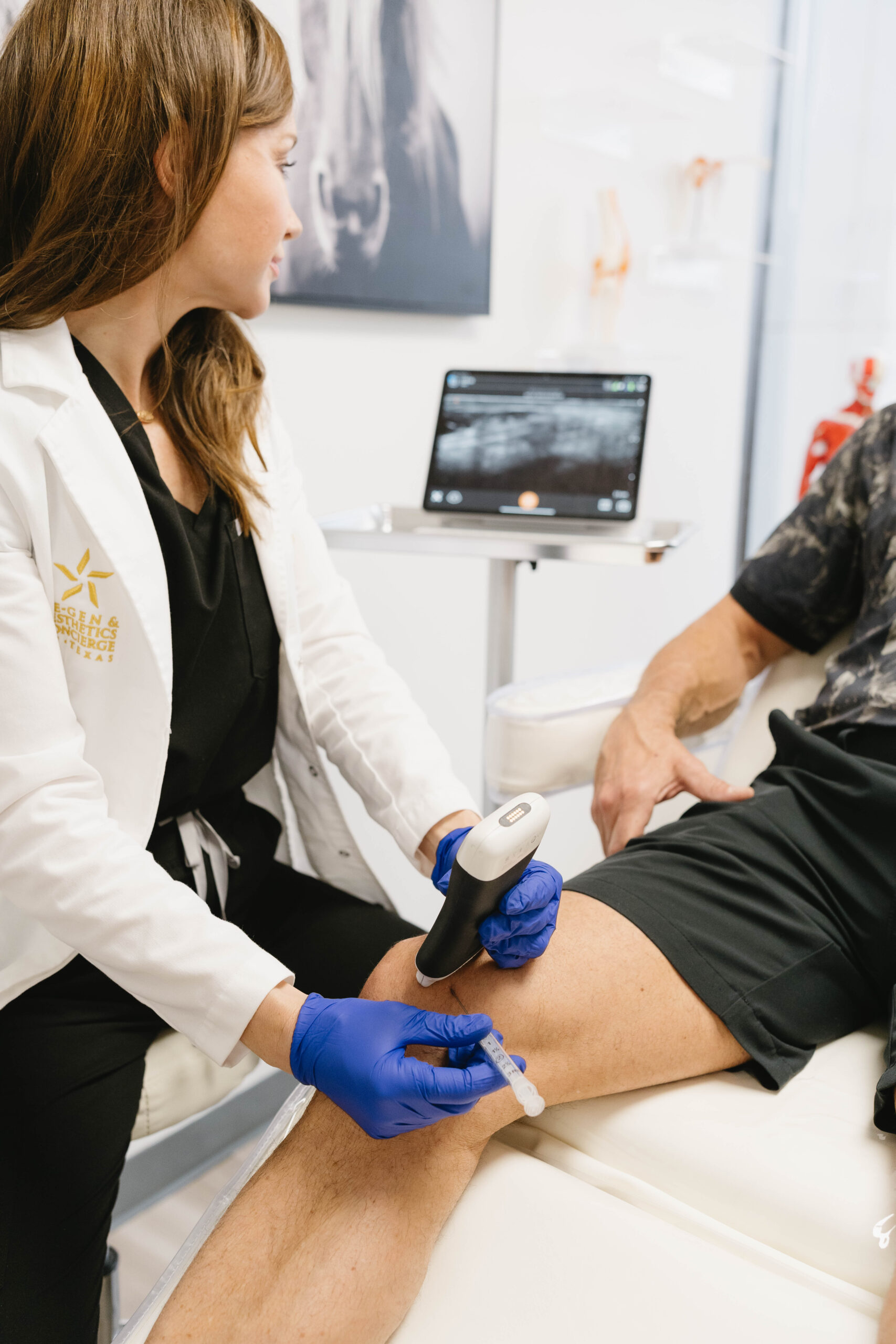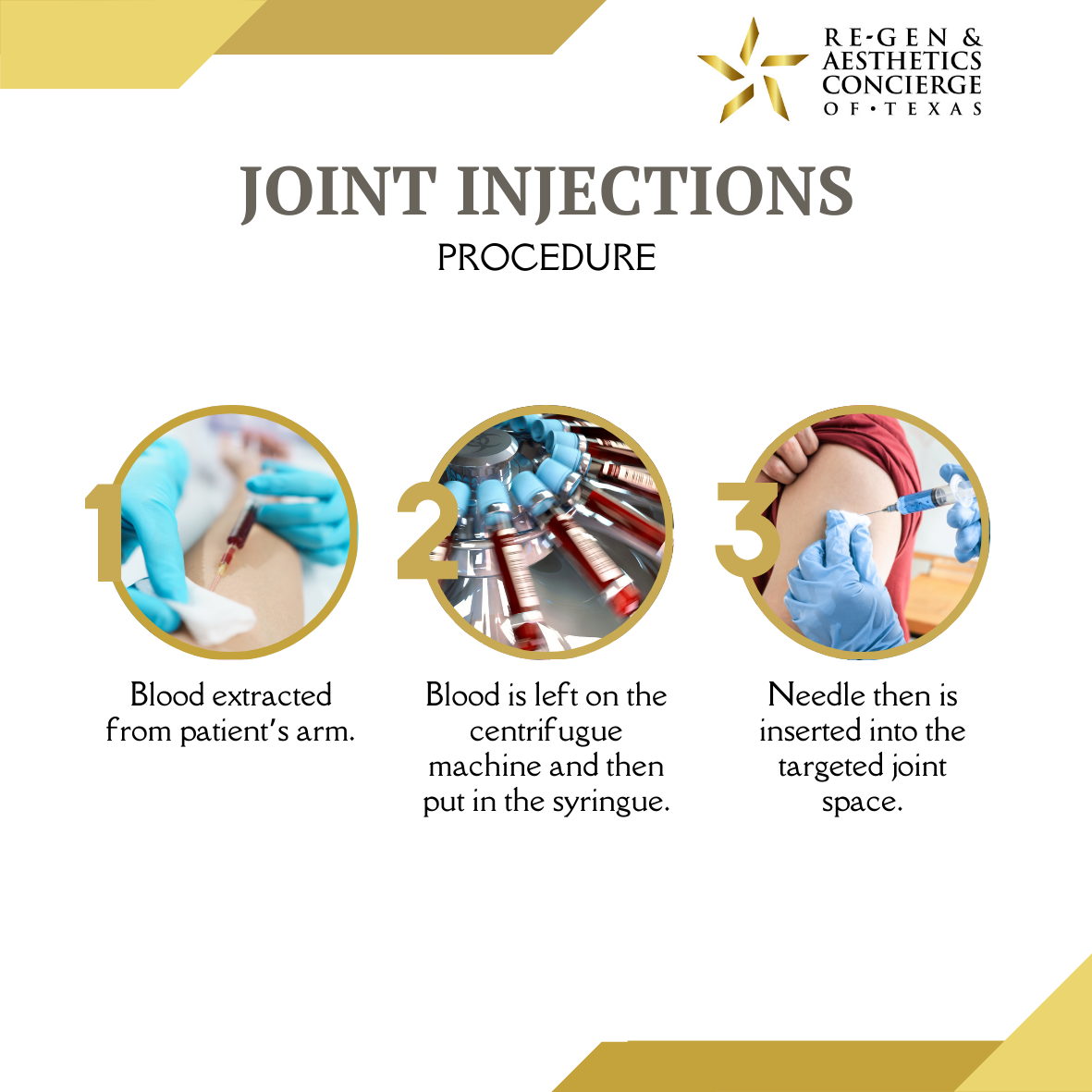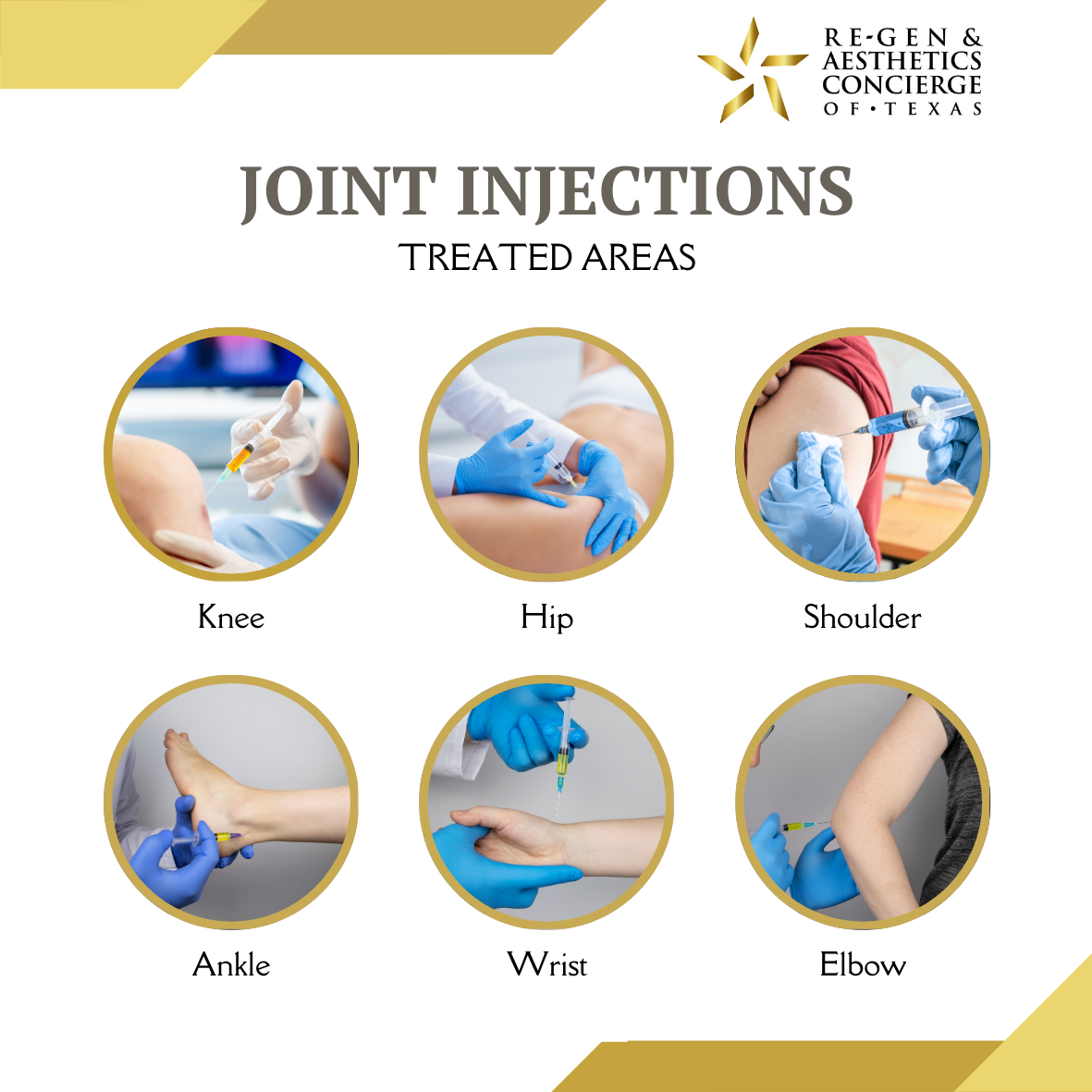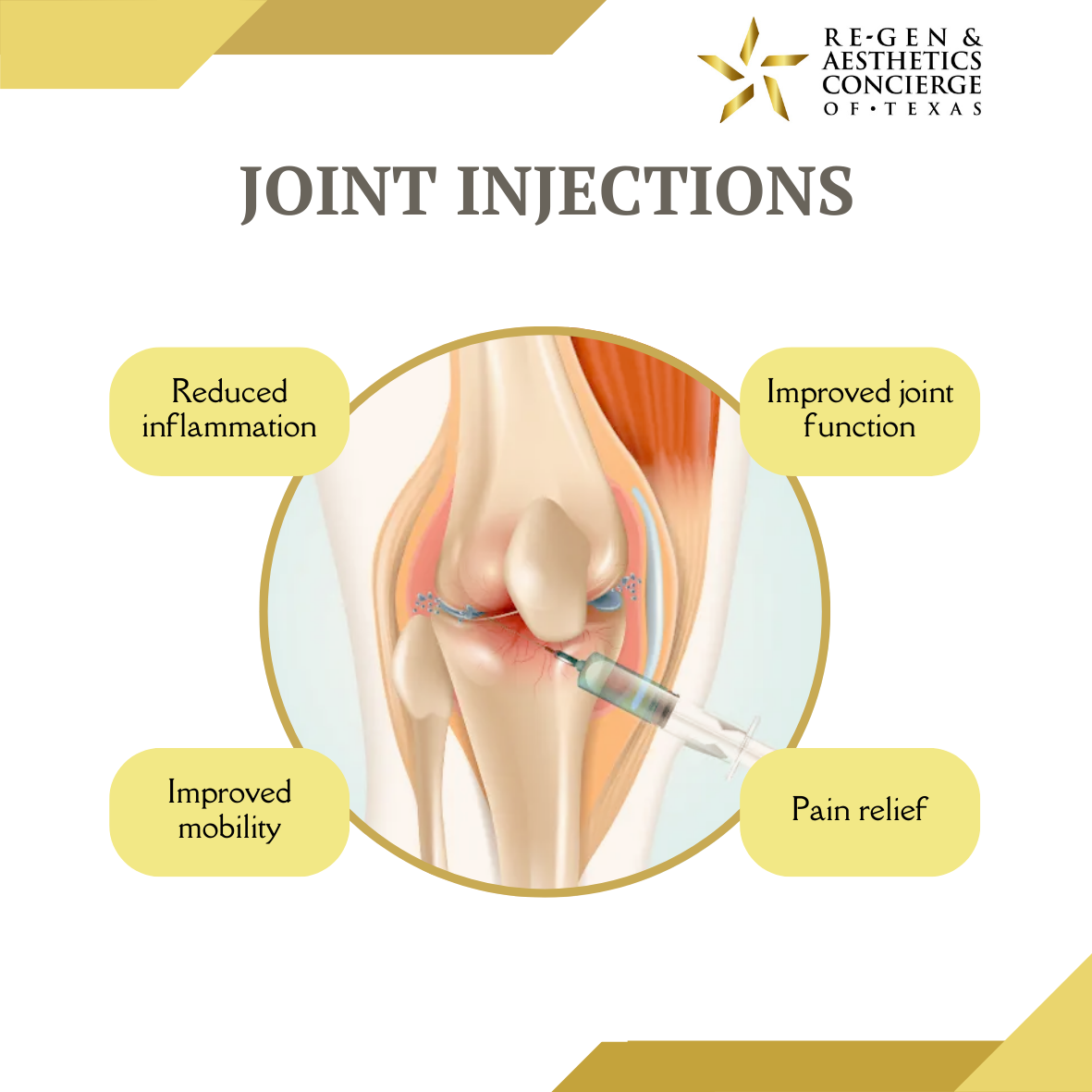REGENERATIVE MEDICINE
PRF (Platelet-Rich Fibrin) Joint Injections
PRF (Platelet-Rich Fibrn) + Exosomes joint injections provide significant benefits for joint health by promoting natural healing and reducing pain.


The therapy involves injecting a concentration of the patient’s own platelets into the affected joint, which releases growth factors and stimulates tissue repair.
This can lead to improved joint function, reduced inflammation, and faster recovery from injuries. PRF injections are particularly effective for conditions like osteoarthritis, tendinitis, and ligament injuries, offering a non-surgical alternative to enhance joint mobility and overall quality of life. Regular PRF treatments can help maintain joint health and alleviate chronic pain. Adding exosomes to PRF amplifies tissue repair, reduces inflammation, and accelerates healing, enhancing the overall effectiveness of treatment. This innovative treatment is replacing steroid injections due to its enhanced safety profile and more enduring outcomes.
Benefits of Injected Exosomes
Regenerative Potential
Exosomes contain bioactive molecules such as proteins, nucleic acids, and lipids that can modulate cellular processes. When injected into damaged or diseased tissues, exosomes may promote tissue repair and regeneration by stimulating cellular proliferation, differentiation, and angiogenesis (formation of new blood vessels).
Anti-inflammatory Effects
Exosomes derived from certain cell types, such as mesenchymal stem cells, have been shown to possess anti-inflammatory properties. Injected exosomes may help modulate immune responses and reduce inflammation in conditions such as arthritis, autoimmune diseases, and inflammatory skin disorders.
Tissue Repair and Wound Healing
Exosomes can accelerate wound healing by promoting cell migration, proliferation, and extracellular matrix synthesis. Injected exosomes may be beneficial in treating chronic wounds, burns, and other injuries by enhancing tissue regeneration and reducing scarring.

Pricing – PRP Injections:
One Joint
Two Joints
Platelet-rich fibrin (PRF) therapy represents a groundbreaking advancement in the field of regenerative medicine, overshadowing its predecessor, platelet-rich plasma (PRP), in terms of effectiveness. This innovative treatment is replacing steroid injections due to its enhanced safety profile and more enduring outcomes.
The typical PRP (Platelet-Rich Plasma) product generally exhibits 2-5 times the platelet concentration found naturally in the body, whereas PRF boasts at least 10 times this concentration.
PRF represents the evolving frontier of platelet-derived regenerative medicine products. We take pride in offering this advanced treatment to our patients!
PRF injections can be used as part of a comprehensive treatment plan and may be recommended in conjunction with other therapies such as Shockwave.
Ready To Book An Appointment?
Ready to schedule your Initial Consultation with our Nurse Practitioners? Click on the link below!
What Are Joint Injections?
PRF and PRP Joint Injections involve the use of the patient’s blood components, specifically platelets, to target joint-related issues. Platelets contain growth factors and other bioactive substances that play a crucial role in tissue regeneration and healing.
Joint pain and discomfort can significantly impact one’s quality of life, hindering mobility and diminishing overall well-being. For those seeking effective and natural solutions, Platelet-Rich Fibrin (PRF) and Platelet-Rich Plasma (PRP) Joint Injections have emerged as innovative therapies with the potential to promote joint health and alleviate symptoms. Let’s delve into the world of PRF/PRP Joint Injections to understand their nature, mechanisms, benefits, and various types.
A small sample of the patient’s blood is drawn, typically from the arm, as in a standard blood test. The blood sample undergoes centrifugation, a process that separates its components based on density. This results in the extraction of concentrated platelets. The concentrated PRF or PRP is injected directly into the affected joint, delivering a potent dose of growth factors and other healing substances.

Ready To Book An Appointment?
Ready to schedule your Initial Consultation with our Nurse Practitioners? Click on the link below!
Areas and Conditions Treated with PRF/PRP Joint Injections

Rejuvenate various parts of your body with our Platelet-Rich Fibrin (PRF) and Platelet-Rich Plasma (PRP) Joint Injections. Our advanced treatments target a range of areas and conditions, including:
- Knee
- Shoulder
- Hip
- Ankle
- Elbow
- Wrist
- Achilles Tendon
- Feet (Plantar Fasciitis)
The decision to use PRF injections in a specific joint depends on the underlying condition, the extent of the injury, and the assessment by our Nurse Practitioner.
Types of Joint Injections
Platelet-Rich Fibrin (PRF) Injections
Platelet-Rich Fibrin, a more advanced form, further concentrates platelets and fibrin, providing a matrix for sustained release of growth factors.
Platelet-Rich Plasma (PRP) Injections
Utilizing the patient’s own blood components, PRP injections stimulate healing and regeneration, making them valuable for tendon and ligament injuries.
Other specific differences between PRP and PRF are: PRF is processed in a centrifuge using a lower spin speed so that the platelet product will remain more pure. There is also the advantage of using less heparin during the processing so that the final product is essentially more pure. The typical PRP product has anywhere from 2-5 times the platelet concentration that we typically have in our body. A PRF product has at least 10 times the platelet concentration we have in our body. Overall, PRF is the direction that platelet-derived regenerative medicine products will be moving in. We are very pleased to offer this product already.

Benefits of PRF/PRP Joint Injections
Natural Healing:
Harnesses the body’s natural healing mechanisms to promote tissue repair and regeneration.
Reduced Inflammation:
Targets inflammation within the joint, reducing pain and swelling.
Improved Joint Function:
Enhances joint lubrication and function, promoting increased range of motion and mobility. This allows better daily performance with greater ease and comfort.
Minimized Downtime:
Generally minimally invasive with quick recovery times compared to surgical interventions.
Personalized Treatment:
Utilizes the patient’s own blood, reducing the risk of allergic reactions or rejection.
Heal and regenerate joint and muscle tissue with PRF injections. Growth factors in PRF
Naturally restore blood flow and cell proliferation to injured tissue, providing healing to painful or injured joints and/or muscles.
Our PRF/PRP Joint Injections Provider: Natalie Ray

The PRP + Exosome Injections are provided by Natalie Ray, an Advanced Practice Registered Nurse (APRN) with a Master’s in Nursing Anesthesia (MNA) and Board Certification in Nurse Anesthesia (CRNA-BC) and Cellular Medicine Association (CMA). With a commitment to excellence, Natalie provides regenerative medicine services in at Re-Gen & Aesthetics Concierge of Texas
Learn More About Our Customer Experience
From patient K.C.:
Omg! I am so impressed with what you did. I had zero swelling, almost no soreness/tenderness. My left hip was a little “achy” for a few days, but took 2 Tylenol that first night and never needed more. Only bruising was in my right inner knee, where you told me there would be a little bruising. Overall my shoulders, hip, and knee felt better instantly, and still feel really good. It’s so nice to be able to move without my hip feeling stiff and sore!!!
I have already told my sister about it and about the O shot to help with urinary frequency and urgency, because she has been doing Botox injections for that. She is going to contact you after the first of the year. Then I want to bring in my mom and dad.
Also, we had a patient, Roxy-she’s an ER nurse at Baylor. I gave her your number because we were talking about our age and how our bodies are starting to feel wear and tear. I told her about my shoulders, hips, and knee and she was SUPER excited to get your information so she can come see you, for face stuff too. 🙌🙌🙌
From patient M.O.
My knee no longer really hurts in the cold. Before the injection, when it was cold I could not even straighten out my knee, and it would hurt. Now I can straighten it, even when it is cold, and it doesn’t hurt!
From patient C.J.:
I had significant pain in my left knee from arthritis and an injury. Prior to this treatment, I had difficulty standing and walking from being seated and struggled to walk downhill or down a set of stairs. My pain was increasing due to my reduced mobility. I had immediate relief after treatment and continued improvement over the weeks since. I am very happy to avoid more invasive procedures and very pleased with the results from this treatment.
Your content goes here. Edit or remove this text inline or in the module Content settings. You can also style every aspect of this content in the module Design settings and even apply custom CSS to this text in the module Advanced settings.
From pt A.W.
Joints are amazing. My elbow is amazing. I feel like I can completely straighten it. My left knee still has a little ache on the inside when it’s bent too long but we focused more on the outside and that’s where I had the bad pain, which is gone now!
PRF/PRP Joint Injections FAQ
In this FAQ section, we will answer some common questions about PRF/PRP joint injections. Whether you’re considering a joint injection or just curious about the procedure, this section will provide you with valuable information to help you make an informed decision.
Please reach us at [email protected] if you cannot find an answer to your question.
How do joint injections work?
The growth factors in the PRF injections work by directly addressing inflammation, promoting joint lubrication, and stimulating the regeneration of damaged tissues. This targeted approach ensures effective relief at the site of the joint problem.
Do joint injections hurt?
Anesthesia is provided in the form of lidocaine injections at the entry sites and along the pathway of the needle, so you will feel pressure with the procedure, but not severe pain. The lidocaine injections do sting, but are typically well tolerated.
How long will results from joint injections last?
The duration of relief varies among individuals and depends on factors such as the type of injection and the specific condition being treated. It is common for patients to experience relief for several weeks to months.
How long do joint injections take?
In general, joint injections are relatively quick and typically fall within the range of 15 minutes to 30 minutes
What can I expect after the procedure?
- You will experience immediate pain relief or reduction in discomfort shortly after the injection.
- You will experience some temporary swelling at the injection site.
- You will notice gradual improvement on your symptoms over the following weeks, since the injected substance stimulates tissue regeneration.
Ready To Book An Appointment?
Ready to schedule your Initial Consultation with our Nurse Practitioners? Click on the link below!
